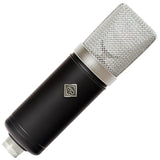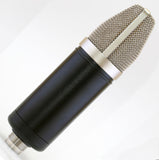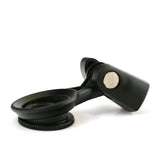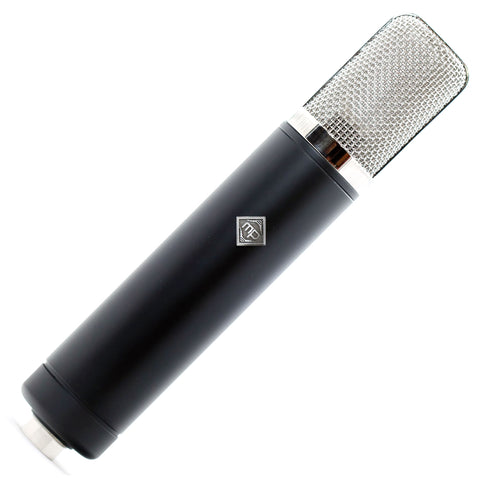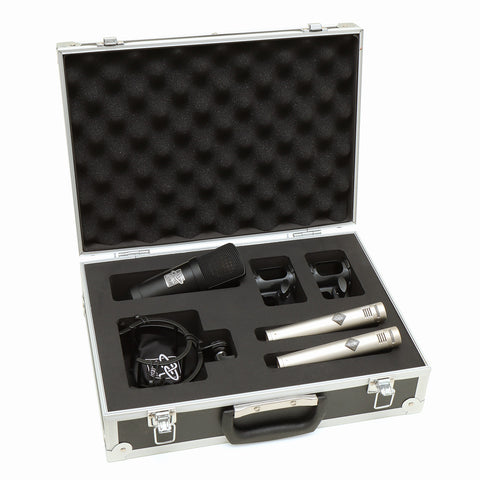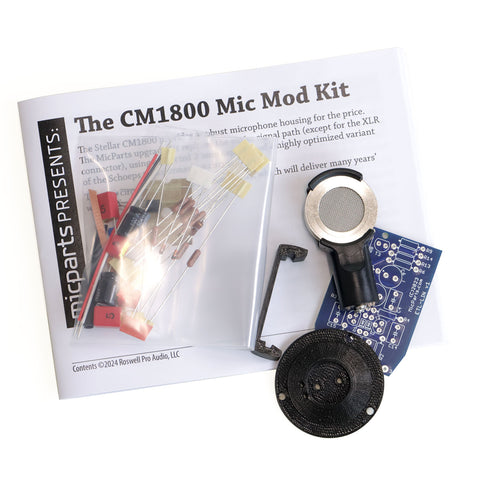S-87 Microphone Kit
$ 379.00

The S-87 is one of our most popular DIY microphone kits. It is a premium studio condenser based on the sound of the Neumann U87 / U87 Ai. In contrast to the U87, the S-87 has higher sensitivity, lower noise, lower distortion, and greater headroom.
"My [S-87] mic build worked the first time I plugged it in and sounds great—as good as other mics I have costing more than double the kit’s price." So says Barry Rudolph, author of more than 200 gear reviews for MIX Magazine.
Applications
The S-87 is an all-purpose microphone. The list of applications below are sources for which the mic shines -- but due to its neutral voicing, it can be used on a wide variety of sources with great results.
- Voiceover (both commercial and narration)
- Vocals
- Percussion
- Drum Overheads
- Orchestra / Ensembles
- Foley
Circuit Description & Options
The S-87 mic has an internal switch that can be configured at build time as either a Cardioid/Omni polar pattern switch, or as a 10dB pad. All parts for both options are included. (If you expect to use the pad frequently, build the S3-87 instead; it provides 3 polar patterns and a switchable pad, via two external switches.)
The high-frequency corrective EQ in the circuit is set at build time. Using included parts, choose from mild or more aggressive roll-off to select the tone that best suits your needs.
The 3rd-generation transformerless circuit kit incorporates numerous upgrades, improvements, and optimizations. We use audiophile-grade parts throughout the circuit: The NOS JFET is from Siliconix, and is manually biased in our shop for every kit to maximize SPL capability and minimize distortion. The bipolar output transistors are NOS parts from Hitachi. The signal capacitors are low-noise, high fidelity parts from Wima. Resistors are 1% tolerance parts from Vishay.
The microphone has high sensitivity — 35mV/Pa or better — with low self-noise (<10dBA). It can be built with user-selectable high-frequency response, from neutral (+0.5dB @ 12kHz) to mildly boosted. It is a wonderful all-purpose condenser, useful on just about any source you can throw at it. Its neutral response makes it easy to stack up in a mix. Pair it with a tube or transformer preamp for additional coloration.
If you need a 3-pattern mic (including Figure-8, for Blumlein or Mid-Side), see the S3-87 kit, which uses a 3-pattern version of this same circuit.
S-87 vs U 87 Ai
The S-87 is not a U87 clone. It's audibly and measurably better in many respects; see detail below.
Most of the mics that claim to be "clones" of the U87 are also not clones. The popular "U87" circuit that shows up in so-called clones is the one Neumann abandoned in 1985. Mics with that old 87i circuit have 15dB lower sensitivity than the S-87, which means you'd need 15dB more preamp gain to get the same signal level into your recording device. The result is a fairly noisy track, because preamps tend to be noisy at high gain settings.
If you compare the S-87 to a new U87 Ai ($3200), you'll find:
- The S-87 has higher output.
- The S-87 has fuller bass response
- The S-87 has lower noise.
- The S-87 has lower distortion.
- The S-87 has more "air" above 12kHz, with a much more gradual rolloff, e.g. 2dB more at 12kHz, 4dB @ 15kHz, etc.
For close mic placements, the S-87 sounds very much like the U87, in that it has flat mids and neutral tonality. Depending on the source, you might or might not hear the "air" in the S-87 track that's missing from the U87 track.
At farther placements (12 inches or greater), the S-87 will sound more balanced, whereas the U87 can sound thin and bright due to its more rolled-off bottom end.
Recent Reviews
I'm part of a producer and songwriter team signed to Sony/ATV and Virgin Records and so we are travelling a lot. We write and produce in big and small studios, AirBnB flats, hotel rooms, cars and tour buses. Sometimes with the biggest ballpark of equipment, sometimes with nothing but our travel setup. We always have your S-87 with us and what impresses the most: It always works. With almost any voice. And then again it does not only work, but it sounds awesome, detailed, smooth, present, not sibilant and so 3D that sometimes I wonder what is going on in here.
We had so many artists on it and everyone loved it. When the record labels love the vocal sound it's the S-87 in most cases!
That's mic we always dreamed of when we spent thousands of euros on all these other mics! We're planning on getting some more.
- Janik Riegert, Sony/ATV Music Publishing
Paul White, senior editor for Sound On Sound Magazine, built an S-12 (which uses the same circuit as the S-87) and concluded that "it could certainly give some of the boutique mics out there a run for their money." That's high praise for a sub-$400 kit.
"A test recording of speech revealed a warm, smooth character without any obvious presence boost... Plenty of HF detail is present, but not in that splashy, in-your-face way that some mics present it, which suggests that it is likely to be kind to female vocals."
Read the full review here.
Here's a video review from Jeannot Kuenzel, with snapshots of an S-12 build (again, using the same circuit as the S-87). It contains a compelling demonstration of the mic's remarkably low noise floor. Note that the S-87's noise floor is actually a few dB lower than the S-12's.
How to Build a Microphone
Every kit includes a comprehensive, full-color manual — 30+ pages of color photographs with arrows and diaphragms and bullet-pointed steps. Customers tell us our documentation is the best they've ever seen.
Nonetheless, we do NOT recommend this as a first-time DIY audio project. Build a stomp box or DI first, or install one of our capsules into an inexpensive condenser. Learn how to solder without spending $300 on a premium microphone kit. And then come back for this — you won't regret it.
See also this video from one of our customers, Chris Goode, who filmed his entire microphone build on an iPhone and made a video of the result:
Visual Color Choices
The S-87 comes in a black painted finish, with the MicParts diamond logo badge on the front.
Alternatively, you can choose from any of several custom powdercoat options by choosing a color and adding it to the same shopping cart as the S-87 kit. See the current inventory of custom color options.
The grille, for all body color options, is a 2-layer brass mesh with satin nickel finish.
What's in the box?
- The S-87 microphone body kit includes an aluminum body sleeve and end cap, mic chassis, capsule deck, domed pedestal mount, brass mesh grille, and pre-wired XLR3M insert. We provide M2 metric machine screws for mounting the circuit boards.
- Swivel mount (See next section for shockmount options.)
- MP-V57 PCB kit: our custom US-made circuit boards, with 100% of components needed to build the circuit, including pre-cut and tinned OFC silver/teflon hookup wire.
- RK-87 capsule, with our proprietary "supersaddle" mount and all necessary screws and wires.
- Full-color, comprehensive installation guide/manual, currently in its 5th revision, incorporating several years' worth of feedback and suggestions from customers.
Upgrade Option
It would be difficult to find components that significantly outperform the ones included in the kit; we do not shortcut any DIY kits by using off-brand, generic, or counterfeit parts.
However, it is possible to manufacture something better than any commonly available parts from the big name brands. One example is our own bespoke electrolytic capacitors. Click here for a bundle discount on the three electrolytic capacitors needed to upgrade the MP-V57 circuit.
Recommended Shockmount
We recommend the Roswell Pro Audio "Cutaway™" shockmount, available exclusively here.
What about matched pairs?
We've sold many matched pairs of the S-87 kit. Just add two of these kits to your cart, and then add the matching option. We will supply your two S-87 kits with a matched pair of RK-87 capsules.
What about Blumlein / Fig-8 / Mid-Side ?
The S-87 is a 2-pattern kit (Cardioid/Omni), assuming you elect to use the single internal switch for pattern control. If you need a 3-pattern mic, or if you want a Fig-8 pattern (for Mid-Side or Blumlein stereo applications), see our S3-87 kit.
(One S-87 and one S3-87 would make a formidable Mid-Side setup!)


